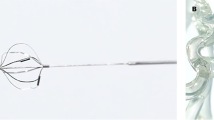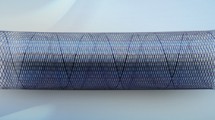Abstract
Introduction
Flow diverters are increasingly being used to treat intracranial aneurysms. This study evaluates occurring complications of flow-diverting devices in the treatment of experimental aneurysms, involving the use of micro-CT and small animal MRI at 9.4 T, in correlation to angiographic and histological findings.
Methods
We previously published two preclinical studies, in which we assessed two different flow diverters in the treatment of elastase-induced aneurysms. Devices have been implanted across the aneurysm neck as well as in the abdominal aorta. From these studies, a total of 65 devices (prototype FD (n = 30) and Derivo embolization device (n = 35)) additionally underwent micro-CT and MRI after angiographic follow-up and before being histologically examined.
Results
The different architectures of both devices were precisely comparable due to high-resolution micro-CT imaging. Micro-CT revealed wire fractures in nine cases (30 %) only with the prototype FD. In three cases (10 %), severe wire fractures correlated with an in-stent stenosis due to intimal hyperplasia. Other complications, like distal stent occlusions and post-stent stenosis, were seen in both groups and verified with both imaging techniques. Osseous metaplasia were correlated to calcifications seen with micro-CT. MRI enabled visualization of the position of the implanted devices relative to the aneurysm and revealed incomplete aneurysm neck coverage with the prototype FD in two cases (6.7 %).
Conclusion
Micro-CT and 9.4-T MRI are valid to discover and understand occurring complications of flow diverters in the preclinical phase and can serve as evaluation tools to minimize complication rates of endovascular devices in the future.







Similar content being viewed by others
Abbreviations
- FD:
-
Flow diverter
- DSA:
-
Digital subtraction angiography
- AA:
-
Abdominal aorta
- SA:
-
Subclavian artery
- ISS:
-
In-stent stenosis
- PSS:
-
Post-stent stenosis
- sMRI:
-
Small animal magnet resonance imaging
- FLASH:
-
Fast low angle shot
- FISP:
-
Fast imaging with steady state precession
- T:
-
Tesla
References
Kallmes DF, Ding Y-H, Dai D, et al. (2007) A new endoluminal, flow-disrupting device for treatment of saccular aneurysms. Stroke 38:2346–2352. doi:10.1161/STROKEAHA.106.479576
Kallmes DF, Ding YH, Dai D, et al. ((2009) A second-generation, endoluminal, flow-disrupting device for treatment of saccular aneurysms. AJNR Am J Neuroradiol 30:1153–1158
Sadasivan C, Cesar L, Seong J, et al. (2009) An original flow diversion device for the treatment of intracranial aneurysms: evaluation in the rabbit elastase-induced model. Stroke 40:952–958. doi:10.1161/STROKEAHA.108.533760
Becske T, Kallmes DF, Saatci I, et al. (2013) Pipeline for uncoilable or failed aneurysms: results from a multicenter clinical trial. Radiology 267:858–868. doi:10.1148/radiol.13120099
Murthy SB, Shah S, Shastri A, et al. (2014) The SILK flow diverter in the treatment of intracranial aneurysms. J Clin Neurosci 21:203–206. doi:10.1016/j.jocn.2013.07.006
van Rooij WJ, Sluzewski M (2010) Perforator infarction after placement of a pipeline flow-diverting stent for an unruptured A1 aneurysm. AJNR Am J Neuroradiol 31:E43–E44. doi:10.3174/ajnr.A2034
Maimon S, Gonen L, Nossek E, et al. (2012) Treatment of intra-cranial aneurysms with the SILK flow diverter: 2 years’ experience with 28 patients at a single center. Acta Neurochir 154:979–987. doi:10.1007/s00701-012-1316-2
Tan LA, Keigher KM, Munich SA, et al. (2014) Thromboembolic complications with pipeline embolization device placement: impact of procedure time, number of stents and pre-procedure P2Y12 reaction unit (PRU) value. J Neurointerv Surg. doi:10.1136/neurintsurg-2014-011111
Kulcsár Z, Houdart E, Bonafé A, et al. (2011) Intra-aneurysmal thrombosis as a possible cause of delayed aneurysm rupture after flow-diversion treatment. AJNR Am J Neuroradiol 32:20–25. doi:10.3174/ajnr.A2370
Turowski B, Macht S, Kulcsár Z, et al. (2011) Early fatal hemorrhage after endovascular cerebral aneurysm treatment with a flow diverter (SILK-stent): do we need to rethink our concepts? Neuroradiology 53:37–41. doi:10.1007/s00234-010-0676-7
Darsaut TE, Rayner-Hartley E, Makoyeva A, et al. (2013) Aneurysm rupture after endovascular flow diversion: the possible role of persistent flows through the transition zone associated with device deformation. Interv Neuroradiol 19:180–185
Tomas C, Benaissa A, Herbreteau D, et al. (2014) Delayed ipsilateral parenchymal hemorrhage following treatment of intracranial aneurysms with flow diverter. Neuroradiology 56:155–161. doi:10.1007/s00234-013-1302-2
Fiorella D, Hsu D, Woo HH, et al. (2010) Very late thrombosis of a pipeline embolization device construct. Neurosurgery 67:onsE313–onsE314. doi:10.1227/01.NEU.0000383875.08681.23
Fischer S, Vajda Z, Perez MA, et al. (2012) Pipeline embolization device (PED) for neurovascular reconstruction: initial experience in the treatment of 101 intracranial aneurysms and dissections. Neuroradiology 54:369–382. doi:10.1007/s00234-011-0948-x
Cohen JE, Gomori JM, Moscovici S, et al. (2013) Delayed complications after flow-diverter stenting: reactive in-stent stenosis and creeping stents. J Clin Neurosci. doi:10.1016/j.jocn.2013.11.010
John S, Bain M, Hui F, et al. (2015) Long-term follow-up of in-stent stenosis after pipeline flow diversion treatment of intracranial aneurysms. Neurosurgery. doi:10.1227/NEU.0000000000001146
Byrne JV, Beltechi R, Yarnold JA, et al. (2010) Early experience in the treatment of intra-cranial aneurysms by endovascular flow diversion: a multicentre prospective study. PLoS One. doi:10.1371/journal.pone.0012492
Briganti F, Napoli M, Tortora F, et al. (2012) Italian multicenter experience with flow-diverter devices for intracranial unruptured aneurysm treatment with periprocedural complications—a retrospective data analysis. Neuroradiology 54:1145–1152. doi:10.1007/s00234-012-1047-3
Estrade L, Makoyeva A, Darsaut TE, et al. (2013) In vitro reproduction of device deformation leading to thrombotic complications and failure of flow diversion. Interv Neuroradiol 19:432–437
Kralev S, Haag B, Spannenberger J, et al. (2010) Expansion of the Multi-Link Frontier™ coronary bifurcation stent: micro-computed tomographic assessment in human autopsy and porcine heart samples. PLoS One 6:e21778–e21778. doi:10.1371/journal.pone.0021778
Keuler A, Taschner C, Brockmann MA, et al. (2014) Comparison of high-resolution X-ray and micro-CT for experimental evaluation of intracranial stent prototypes: quality evaluation beyond CE mark. Neuroradiology. doi:10.1007/s00234-014-1324-4
Fries P, Seidel R, Müller A, et al. (2013) Comparison of self-gated and prospectively triggered fast low angle shot (FLASH) sequences for contrast-enhanced magnetic resonance imaging of the liver at 9.4 T in a rat model of colorectal cancer metastases. Investig Radiol 48:738–744. doi:10.1097/RLI.0b013e318294dd0e
Simgen A, Ley D, Roth C, et al. (2013) Evaluation of a newly designed flow diverter for the treatment of intracranial aneurysms in an elastase-induced aneurysm model, in New Zealand white rabbits. Neuroradiology. doi:10.1007/s00234-013-1296-9
Ley D, Mühl-Benninghaus R, Yilmaz U, et al. (2015) The Derivo embolization device, a second-generation flow diverter for the treatment of intracranial aneurysms, evaluated in an elastase-induced aneurysm model. Clin Neuroradiol. doi:10.1007/s00062-015-0493-9
Cloft HJ, Altes TA, Marx WF, et al. (1999) Endovascular creation of an in vivo bifurcation aneurysm model in rabbits. Radiology 213:223–228. doi:10.1148/radiology.213.1.r99oc15223
Cremers B, Kelsch B, Clever YP, et al. (2012) Inhibition of neointimal proliferation after bare metal stent implantation with low-pressure drug delivery using a paclitaxel-coated balloon in porcine coronary arteries. Clin Res Cardiol 101:385–391. doi:10.1007/s00392-011-0408-y
North American Symptomatic Carotid Endarterectomy Trial (1991) Methods, patient characteristics, and progress. Stroke 22:711–720
Adlakha SS, Sheikh MM, JJ W, et al. (2010) Stent fracture in the coronary and peripheral arteries. J Interv Cardiol 23:411–419. doi:10.1111/j.1540-8183.2010.00567.x
Valibhoy AR, Mwipatayi BP, Sieunarine K (2007) Fracture of a carotid stent: an unexpected complication. J Vasc Surg 45:603–606. doi:10.1016/j.jvs.2006.08.086
Ling AJ, Mwipatayi P, Gandhi T, et al. (2007) Stenting for carotid artery stenosis: fractures, proposed etiology and the need for surveillance. J Vasc Surg 47:1220–1226. doi:10.1016/j.jvs.2008.01.043
Ionescu M, Metcalfe RW, Cody D, et al. (2010) Spatial resolution limits of multislice computed tomography (MS-CT), C-arm-CT, and flat panel-CT (FP-CT) compared to microCT for visualization of a small metallic stent. Acad Radiol 18:866–875. doi:10.1016/j.acra.2011.02.012
Gross BA, Frerichs KU (2013) Stent usage in the treatment of intracranial aneurysms: past, present and future. J Neurol Neurochir Psychiatr 84:244–253. doi:10.1136/jnnp-2011-302007
Berge J, Biondi A, Machi P, et al. (2012) Flow-diverter silk stent for the treatment of intracranial aneurysms: 1-year follow-up in a multicenter study. AJNR Am J Neuroradiol 33:1150–1155. doi:10.3174/ajnr.A2907
Dai DD, Ding YHY, Kadirvel RR, et al. (2007) Bone formation in elastase-induced rabbit aneurysms embolized with platinum coils: report of 2 cases. AJNR Am J Neuroradiol 28:1176–1178. doi:10.3174/ajnr.A0507
Dai D, Ding YH, Kadirvel R, et al. (2012) Patency of branches after coverage with multiple telescoping flow-diverter devices: an in vivo study in rabbits. AJNR Am J Neuroradiol 33:171–174. doi:10.3174/ajnr.A2879
Acknowledgments
We would like to thank the head of Department of Experimental Surgery, Prof. Menger, and his team for supporting this study. This study was supported in part by a research grant from the BMBF (German Ministry of Education and Research, Grant number: 0314101) and the BMWi (German Ministry of Economic Affairs and Energy, Grant number: KF2335801WL9).
Author information
Authors and Affiliations
Corresponding author
Ethics declarations
We declare that all human and animal studies have been approved by the ethics committee of the Saarland University and have therefore been performed in accordance with the ethical standards laid down in the 1964 Declaration of Helsinki and its later amendments. We declare that all patients gave informed consent prior to inclusion in this study.
Conflict of interest
This study was funded by Acandis GmbH, Pforzheim, Germany. GFMC, an engineer at the company, served as proctor during this study.
Additional information
Parts of this study have been published as an oral poster presentation at the meeting of the German Society of Neuroradiology (DGNR) in Cologne, Germany, in October 2013, and as an oral presentation at the XXth Symposium Neuroradiologicum Istanbul, Turkey, in September 2014. Additionally, parts of this study have been published in the Journal of Neuroradiology in 2013, and in Clinical Neuroradiology in 2015.
Rights and permissions
About this article
Cite this article
Simgen, A., Ley, D., Roth, C. et al. Evaluation of occurring complications after flow diverter treatment of elastase-induced aneurysm in rabbits using micro-CT and MRI at 9.4 T. Neuroradiology 58, 987–996 (2016). https://doi.org/10.1007/s00234-016-1730-x
Received:
Accepted:
Published:
Issue Date:
DOI: https://doi.org/10.1007/s00234-016-1730-x




